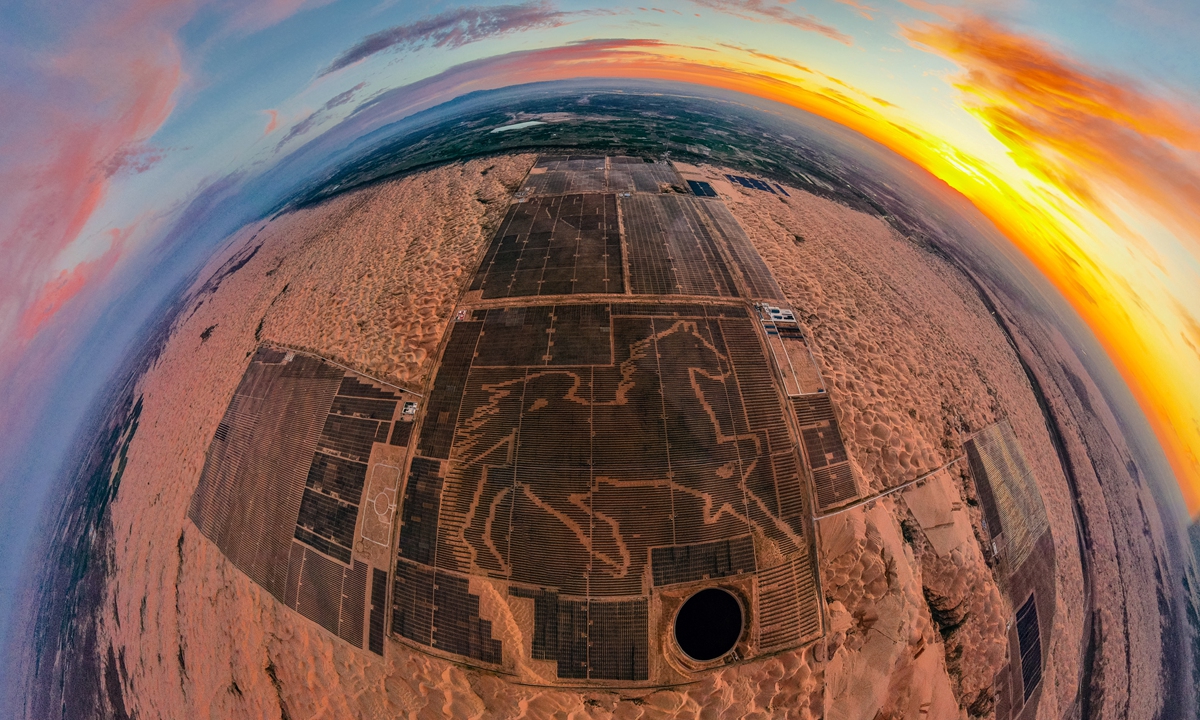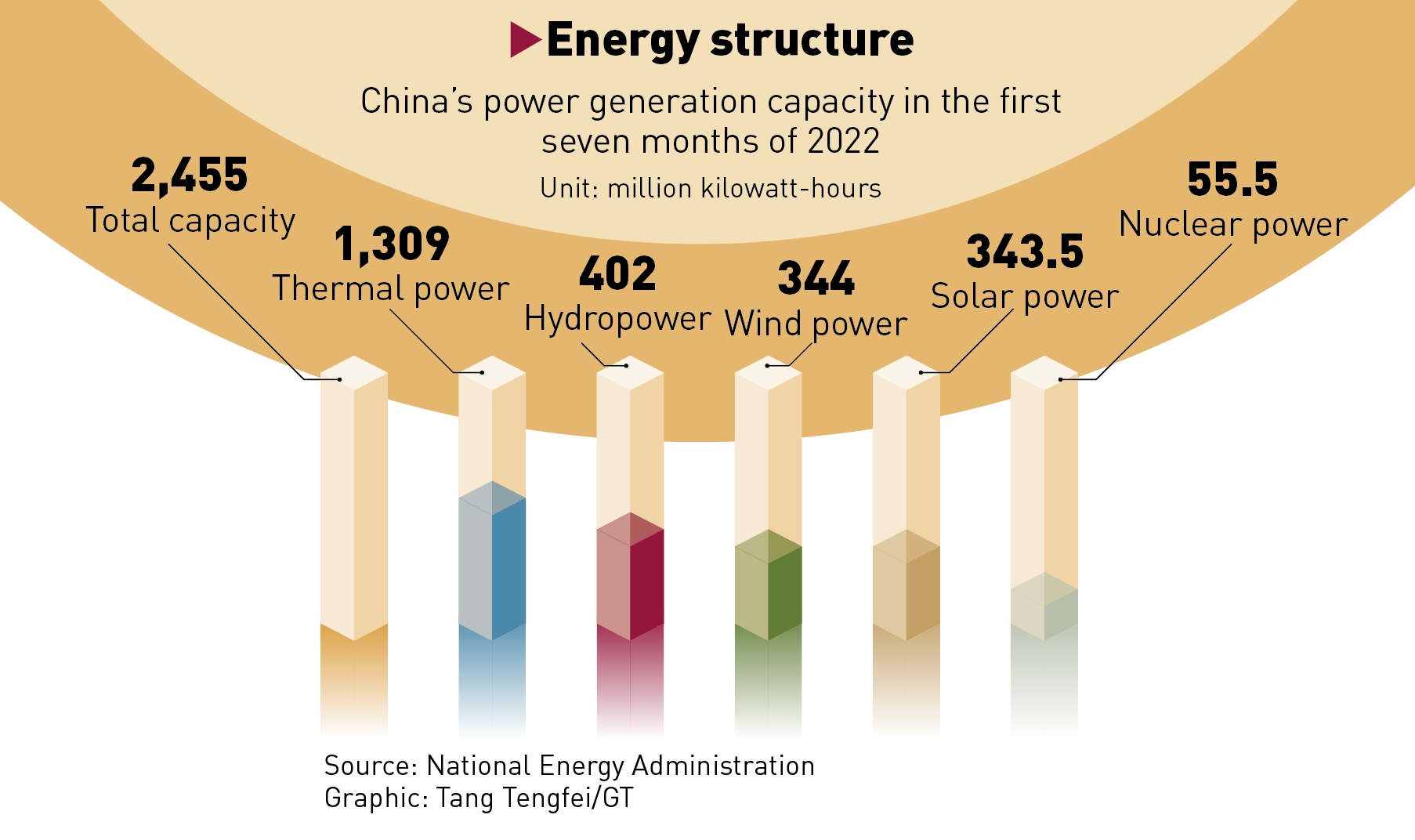
Aerial view of the horse-shaped solar power station at the Kubuqi Desert in Ordos, North China's Inner Mongolia Autonomous Region Photo: Courtesy of the State Power Investment Corporation Nei Mongol Energy Co
Strolling around the Junma Solar Power Station located in the Kubuqi Desert in Ordos, North China's Inner Mongolia Autonomous Region, it's hard for visitors to imagine that the area, now covered with blue solar panels and green vegetation, was once being totally barren and called the "sea of death".
Occupying an area of around 1.4 million square meters and composed of more than 196,000 photovoltaic panels to form the pattern of a galloping horse, the station is not only the largest desert PV station in China, but is also the largest solar panel image in the world and owner of a Guinness World Record.
That's also where its name comes from, as Junma literally means horse in Chinese.
So far, the project has generated more than 2.312 billion kilowatt-hours (kWh) of green electricity, which is equivalent to saving 760,000 tons of standard coal and reducing carbon dioxide emissions by 1.85 million tons, the State Power Investment Corporation (SPIC) Nei Mongol Energy Co, the project contractor, told the Global Times on Saturday.
While developing and utilizing solar energy resources, the project is also used to promote desert ecological governance. As of today, a total of 16,000 mu of desert has been transformed, according to the company.
The solar farm, which has been put into operation for more than three years and in the progress of further expansion, indeed represents the latest practice of how China has successfully promoted its clean energy push into the most sandy and rocky regions in the country, and meanwhile using renewable energy to combat desertification and reduce poverty.
'Horse' in desertThe Junma station is a part of the Dalad Photovoltaic Power Base in the Kubuqi Desert, the seventh largest desert in China, which was approved by the National Energy Administration in November 2017.
The construction comes as China - already a world leader in renewable energy innovation and production - has been ambitiously expanding its solar and wind power projects across the country to achieve clean climate targets over the past years.
"Building a photovoltaic power station in the desert is not easy, and requirement for solar equipment is higher due to the windy and sandy environment in the desert," Miao Ruijun, deputy head of Mengxi New Energy Dalad Photovoltaic Power Station in SPIC Nei Mongol Energy Co, told the Global Times at the site on Saturday.
Miao noted that to better manage running of the station in the desert environment and save personnel needed onsite, it has adopted smart PV solutions provided by Huawei Technologies, including solar inverters, power carrier communication (PLC), intelligent IV diagnosis, as well as intelligent photovoltaic management system.
"With just one-click scanning in the main control room, we can detect different problems in half an hour and accurately monitor every part of the module," Li Shuaikun, a safety technician at the station and a staff at SPIC Nei Mongol Energy Co, told the Global Times on Saturday, noting that with only two staff working at the main control room, they can monitor all the equipment situation in the Junma station, greatly saving personnel and improve efficiency.
Li said that, currently, power generated by the solar station mainly serves the electricity demand for nearby industrial park, greatly slash the production needed by coal-fired power plants.

Graphic: Tang Tengfei/GT
Ecological balance
In addition to bringing green energy to local people and industries, the solar power station also functions to control desertification and create income for local residents as they can grow plants and graze among and under the solar panels.
An improved soil situation and environment also allows more diverse industries to survive, such as organic farming and desert tourism.
"Now we have planted economic forests such as Amorpha and Astragalus between the photovoltaic arrays, and planted sand shrubs and grasses under the photovoltaic panels to achieve wind and sand fixation and ecological restoration," Zhang Lihua, general manager of Mengxi New Energy at SPIC Nei Mongol Energy Co, told the Global Times.
"Photovoltaic panels can not only generate electricity, but also block the wind and improve the living environment of the plants under the extending solar panels," Zhang said.
In order to promote the upgrading and development of the base, the local area also uses the drained water from the nearby coal mine as the water source. Through the water quality improvement project, the drained water from the coal mine is converted into the industrial water at the base.
Looking ahead, local authorities said they are aiming to combine the resources from the photovoltaic industry, desert organic agriculture, desert tourism as well as rural revitalization, so that to build up the "desert economy" and further improve local livelihoods.
The success of this project, which explains how a huge solar farm has combined energy generation with land restoration, also offers a precious experience for both China and the world, raising hopes for governments to use the clean and renewable energy to vitalize more "deadly" deserts into oasis, industry observers said.
The world's second-largest economy is also on the fast track of expanding the experience to uplift more of the country's outlying and relatively poor regions.
China plans to build 450 gigawatts of solar and wind power generation capacity on the Gobi and other desert regions, the state planner said in March. By the end of 2021, China had installed 306 gigawatts of solar power capacity and 328 gigawatts of wind turbines, with construction of about 100 gigawatts of solar power capacity is already under way in the desert regions.





